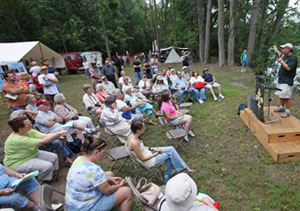A Typical Day at 20BE23
Hello all! It’s Abby again from N34 E16, and I’d love to walk you through a typical day in the Fort Saint Joseph Archaeological Field School.
We start the day with breakfast from 7-7:30AM, but since most of my comrades choose to sleep in, there is plenty of space in the home-ec room to do some early morning reading while we eat. At 8AM, we head out to the loading dock for any announcements and to load up the vans to head to the site.

When we arrive to the site we unload the water coolers from the van and supplies from the trailer. It’s about two trips per person carrying down buckets, dustpans, toolboxes, and various other materials. Then we each gather the supplies our units need and uncover the excavation units. That’s when the real excitement begins!
We measure our unit depths so we can refresh ourselves how far we have to trowel down. As we trowel, we make sure that we’re not creating a bumpy floor or slanted walls. We also make sure that we are being careful to not damage any artifacts underneath the soil by troweling gently, and around anything large we can see. As we trowel, we accumulate a LOT of dirt; digging down 5cm in one half of a 1x2m unit can produce about 5-6 kitty litter buckets. Once we have two buckets, we haul them over to the wet screening area and put them in the queue of buckets and continue digging until our unit coordinates are called. Then someone from the unit goes up and wet-screens the buckets of dirt.
 |
| Lunch break |
Wet-screening is a tedious, but fun (at least it is for me) task. Depending on the person, half or a full bucket gets dumped into the screen. Then we have to push the mound down flatter and begin the boring task of spraying down the dirt. As you rinse dirt through the screen you begin to look for artifacts. The easiest thing to find is the large pieces of bone found in almost every excavation unit. The real interesting pieces, that demand a more watchful eye, are things such as beads, chunks of charcoal, flakes of glass, calcined bone, pieces of shell and metal, as well as countless other items.
At 12PM, we eat lunch, which consists of sandwiches made by a crew the night before. We have other snacks, and everyone takes the time to mingle with people in units further away, and most importantly, HYDRATE! At 12:30PM sharp, it’s back down to the site for pit tours. During pit tours, we walk around to each excavation unit, and the excavators explain what’s going on in their unit and what they plan on doing next. This also allows for numerous “Teaching Moments” courtesy of Dr. Nassaney, as we encounter things we maybe haven’t seen yet.
 |
| Joe rocks the pit tour. |
After pit tours, everyone gets back to work; diggers get digging and wet-screeners get wet-screening. Some pits switch up jobs, others don’t, and it all depends on the unit. Personally, I’m a fan of the wet-screen since it gives us the opportunity to rinse off and cool down, and I’m not terribly good at mapping or keeping floors level anyways, so I’m sure Joe and Cathrine (PPP love!) don’t mind me being away. The Party Pit crew also takes time to seethe at Greg & Amber’s unit, which is commonly joked about as needing a ladder to get in & out of because it’s so much deeper than everyone else’s, and we’re sick of constantly having to belay them down their hole. This continues on through the afternoon, and around 4-4:30PM we cover our excavation units with tarps and break for the day.
We arrive back at the school and have around an hour to clean up and relax before dinner at 6PM. After we eat, we have lab at 7PM until around 9PM.
 |
| Wet-screen! |
During lab, there are numerous tasks set out for us by the lab TA, Alyssa, to do. The two main activities are wash and sort. Wash entails exactly what it sounds like; we take bags of artifacts from the day, and take them, individually to wash/clean them. Certain things, such as charcoal and metal aren’t supposed to get wet, so we use a dry brush and dental pick to clean them. Items like bone, beads and glass can get wet, so we take a wet brush and clean them off. Then we carefully set them onto drying racks until they’re completely dry so that we can sort them. When we sort, we divide the items in the trays into different categories, and bag them with labels. Bones generally take longer to dry than other artifacts, so we usually leave those to the side for a few days longer before being bagged up. All metal artifacts must include a silica packet (you know, those annoying things in new shoes, bags, & vitamin containers) to stabilize the metal after it’s been removed from its comfortable home in the dirt.
When lab is done, various things happen; some people go to bed or the store, some people make lunch for the next day, and some people go out to escape from living in a high school for just a little while. I feel some days as if this were camp, since we live, eat, sweat and do almost everything else together as a group. Something that happens throughout the day, thanks to having an amazing class this field season, is camaraderie. And that, dear lovers of the FSJ blog, is what makes it worth waking up the next day to dig.
Peace, Love & Dirt,
Abby Stoner
Photo credits Alyssa Klubeck, Amber Strick, Erica D'Elia, and Cathrine Davis
 Hi folks,
Hi folks,
















